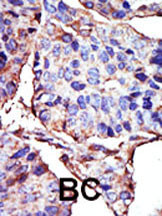BGLF4 Antibody (C-term)
Purified Rabbit Polyclonal Antibody (Pab)
- SPECIFICATION
- CITATIONS: 3
- PROTOCOLS
- BACKGROUND

Application
| IHC-P, E |
|---|---|
| Primary Accession | P13288 |
| Reactivity | Human |
| Host | Rabbit |
| Clonality | Polyclonal |
| Isotype | Rabbit IgG |
| Calculated MW | 48351 Da |
| Antigen Region | 386-417 aa |
| Gene ID | 3783704 |
|---|---|
| Other Names | Serine/threonine-protein kinase BGLF4, BGLF4 |
| Target/Specificity | This BGLF4 antibody is generated from rabbits immunized with a KLH conjugated synthetic peptide between 386-417 amino acids from the C-terminal region of human BGLF4. |
| Dilution | IHC-P~~1:50~100 |
| Format | Purified polyclonal antibody supplied in PBS with 0.09% (W/V) sodium azide. This antibody is prepared by Saturated Ammonium Sulfate (SAS) precipitation followed by dialysis against PBS. |
| Storage | Maintain refrigerated at 2-8°C for up to 2 weeks. For long term storage store at -20°C in small aliquots to prevent freeze-thaw cycles. |
| Precautions | BGLF4 Antibody (C-term) is for research use only and not for use in diagnostic or therapeutic procedures. |
| Name | BGLF4 |
|---|---|
| Function | Plays many key roles by phosphorylating several proteins including the viral DNA processivity factor BMRF1, EBNA1 or EBNA2. Modifies the host nuclear envelope structure and induces the redistribution of nuclear envelope-associated proteins by phosphorylating host nucleoporins. Subsequently, promotes the nuclear transport of EBV lytic proteins. Required for efficient lytic DNA replication and release of nucleocapsids from the nucleus. Contributes to the compaction of host cell chromatin in cells undergoing lytic replication, presumably by phosphorylating the host condensin complex and host TOP2A. Induces disassembly of the nuclear lamina by phosphorylating with host LMNA. Phosphorylates substrates involved in capsid assembly and DNA packaging. Facilitates the switch from latent to lytic DNA replication by down-regulating EBNA1 replication function. Phosphorylates the viral immediate-early protein BZLF1 and inhibits its sumoylation by interacting with host SUMO1 and SUMO2. Phosphorylates also host SAMHD1 and thereby counteracts its antiviral effect by reducing its dNTP hydrolase activity. |
| Cellular Location | Virion tegument. Host nucleus. Note=the protein is present at discrete sites in nuclei, called replication compartments where viral DNA replication occurs |

Provided below are standard protocols that you may find useful for product applications.
Background
Protein kinases are enzymes that transfer a phosphate group from a phosphate donor, generally the g phosphate of ATP, onto an acceptor amino acid in a substrate protein. By this basic mechanism, protein kinases mediate most of the signal transduction in eukaryotic cells, regulating cellular metabolism, transcription, cell cycle progression, cytoskeletal rearrangement and cell movement, apoptosis, and differentiation. With more than 500 gene products, the protein kinase family is one of the largest families of proteins in eukaryotes. The family has been classified in 8 major groups based on sequence comparison of their tyrosine (PTK) or serine/threonine (STK) kinase catalytic domains. The STE group (homologs of yeast Sterile 7, 11, 20 kinases) consists of 50 kinases related to the mitogen-activated protein kinase (MAPK) cascade families (Ste7/MAP2K, Ste11/MAP3K, and Ste20/MAP4K). MAP kinase cascades, consisting of a MAPK and one or more upstream regulatory kinases (MAPKKs) have been best characterized in the yeast pheromone response pathway. Pheromones bind to Ste cell surface receptors and activate yeast MAPK pathway.
References
Smith, R.F., et al., J. Virol. 63(1):450-455 (1989).
Baer, R., et al., Nature 310(5974):207-211 (1984).
If you have used an Abcepta product and would like to share how it has performed, please click on the "Submit Review" button and provide the requested information. Our staff will examine and post your review and contact you if needed.
If you have any additional inquiries please email technical services at tech@abcepta.com.














 Foundational characteristics of cancer include proliferation, angiogenesis, migration, evasion of apoptosis, and cellular immortality. Find key markers for these cellular processes and antibodies to detect them.
Foundational characteristics of cancer include proliferation, angiogenesis, migration, evasion of apoptosis, and cellular immortality. Find key markers for these cellular processes and antibodies to detect them. The SUMOplot™ Analysis Program predicts and scores sumoylation sites in your protein. SUMOylation is a post-translational modification involved in various cellular processes, such as nuclear-cytosolic transport, transcriptional regulation, apoptosis, protein stability, response to stress, and progression through the cell cycle.
The SUMOplot™ Analysis Program predicts and scores sumoylation sites in your protein. SUMOylation is a post-translational modification involved in various cellular processes, such as nuclear-cytosolic transport, transcriptional regulation, apoptosis, protein stability, response to stress, and progression through the cell cycle. The Autophagy Receptor Motif Plotter predicts and scores autophagy receptor binding sites in your protein. Identifying proteins connected to this pathway is critical to understanding the role of autophagy in physiological as well as pathological processes such as development, differentiation, neurodegenerative diseases, stress, infection, and cancer.
The Autophagy Receptor Motif Plotter predicts and scores autophagy receptor binding sites in your protein. Identifying proteins connected to this pathway is critical to understanding the role of autophagy in physiological as well as pathological processes such as development, differentiation, neurodegenerative diseases, stress, infection, and cancer.

